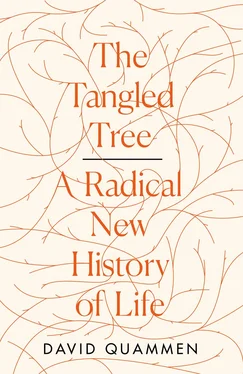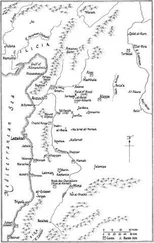Although many bacteria live as solitary cells, taking their chances and meeting their needs independently, others aggregate into pairs, clusters, little scrums, chains, and colonies. The coccoid cells of Neisseria gonorrhoeae , which cause gonorrhea, lump together by twos, forming bilobed units resembling coffee beans. The genus Staphylococcus gets its name from Greek words for “granule” ( kókkos , the spheroid aspect) and “a bunch of grapes” ( staphylè ), because staph cells tend to bunch. Most of the forty staph species are harmless, but Staphylococcus aureus can inflict skin infections, sinus infections, wound infections, blood infections, meningitis, toxic shock syndrome, plus other nasty conditions, and if you’re so unlucky as to pick up a dose of those little grapes in one of their antibiotic-resistant forms, such as MRSA, a monstrous product of horizontal gene transfer (as I’ve mentioned, and to which I’ll return), you could be in a world of hurt. Cells of Streptococcus species, including those that cause impetigo and rheumatic fever, stick together like beads on a chain.
Bacteria can also form stubborn, complex films on certain surfaces—the rocks of a sea floor, the glass wall of an aquarium, the metal ball of your new artificial hip—where they may cooperate together in exuding a slimy extracellular substance that helps nurture them collectively, maintain the stability of their little environment, serve as a sort of communications matrix among them, and even protect them from antibiotics. These living slicks, known as biofilms, can be thinner than tissue paper or as thick as a good dump of snow, and may incorporate multiple species. The little rods of Acinetobacter baumannii are infamous for their ability to lay down persistent biofilms on dry, seemingly clean surfaces in hospitals.
Cyanobacteria, including that monumentally abundant Prochlorococcus , convert light to energy and deliver, as byproduct, a large share of Earth’s free atmospheric oxygen. Purple bacteria photosynthesize too, but do it by drawing upon sulfur or hydrogen instead of water as fuel for the process, and they don’t produce oxygen. Lithotrophic bacteria, the rock eaters, deriving their energy from iron, sulfur, and other inorganic compounds, exist in more ingenious variants than you care to know. Japanese researchers have recently discovered a new bacterium, Ideonella sakaiensis , that digests plastic. Certain enterprising ocean bacteria, such as Marinobacter salarius , have risen to the challenge of degrading hydrocarbons from the Deepwater Horizon oil spill. Other bacteria are quite capable, in the presence of oxygen or without it, of feasting on garbage, sewage, various inorganic compounds, plants, fungi, and animal tissue, including human flesh. Lactic acid bacteria, which may be rod shaped or spherical, turn up in milk products, busy at their task of carbohydrate fermentation and resistant to the acid they create. Many of them also like beer.
Not all such particulars were known to Carl Woese in 1977 as he examined the fingerprints from his first few methanogens. But the vast scope, ubiquity, and multifariousness of bacteria certainly were. The terrain of bacteriology was known even better to Ralph Wolfe, who had trained in the classic fundamentals under van Niel and others. Woese’s reaction to his own preliminary results must have seemed all the more radical, then, all the more shocking, as he shared it not just with George Fox and members of his own lab but also with Wolfe, just after they repeated the rRNA analysis of delta H, the first methanogen. “ Carl’s voice was full of disbelief,” Wolfe wrote in a memoir, “when he said, ‘Wolfe, these things aren’t even bacteria.’”
Ralph Wolfe told me the same story, with some elaboration, thirty-nine years later when I called on him in Urbana. By then, he was an emeritus professor of microbiology, ninety-three years old, a frail and slender gentleman with a quick smile, still maintaining his office and coming to it, as though retirement were not an entirely satisfying option. On the wall behind his desk hung a replica of Alessandro Volta’s pistola , a gunlike device invented by Volta in the late 1770s for testing the flammability of swamp gases, including methane. On the desk itself were papers and books and a computer.
Woese’s lab back in the day had been in Morrill Hall, on South Goodwin Avenue, and Wolfe’s was in an adjacent building, connected by a walkway. Woese would occasionally trundle over on various business. “He came down the hall and happened to see me,” Wolfe recalled, “and says, ‘Wolfe, these things aren’t even bacteria!’” Wolfe laughed gently and, for my benefit, continued reenacting the scene.
“‘Of course they are, Carl.’” They look like bacteria in the microscope, Wolfe had told him. But Woese wasn’t using a microscope. He never did. He was using ribosomal RNA fingerprints.
“‘Well, they’re not related to anything I’ve seen.’” Coming back to the present, Wolfe said: “That was the pivotal statement that changed everything.”
23

We went into fast-forward mode,” Woese recalled in his account of these events. By the end of 1976, his team had done fingerprints and catalogs on five additional methanogens, with more in the pipeline. And sure enough, he wrote, none of the new catalogs was prokaryotic, not in the prevailing sense of that word, which meant bacteria and only bacteria. None of the organisms was eukaryotic, either. But “they were all of a kind!”—a third kind, something else, something anomalous, something hitherto unsuspected to exist. Woese started thinking that he would need to declare a new kingdom of life—create a new name, invent a huge new category—to recognize their uniqueness and contain them. It wasn’t really a new kingdom, of course. It was a newly discovered natural grouping of life-forms, which had existed apart for a long time, unrecognized, and which might be called a “kingdom” or an “urkingdom” or a “domain,” according to preferred human convention.
Woese believed that this discovery, still unannounced, offered “ a rare opportunity to put the theory of evolutionto serious predictive test.” He meant Darwin’s theory of evolution, as opposed to any others—the one that recognized hereditary continuity plus a degree of random variation over long stretches of time, and explained the shaping of that variation, to yield adaptation and diversity, mainly by way of natural selection. If Woese’s preliminary findings were correct, he noted, those findings should serve as a guide for predicting roughly what further data and discoveries would appear. From the premise that 16S rRNA represented a very slow-ticking molecular clock, with a minimum of selected variation, he deduced that his newly found kingdom must represent a very old division. Very old—having originated near the beginning of cellular life, maybe three and a half billion years ago. Now he would try to sketch its boundaries and its characteristics. As he and his team added more microbes to its membership—more methanogens and maybe other creatures too, each known by its catalog of RNA fragments—Woese expected two things: that this unnamed kingdom would remain dramatically distinct from the rest of the living world and that it would nonetheless encompass great diversity. “ Testing these two main evolutionary predictions,” he wrote, “drove our work from that point on.”
Читать дальше













